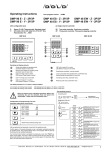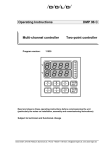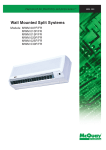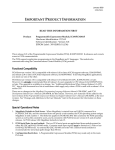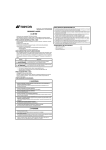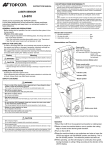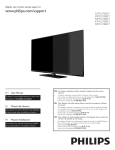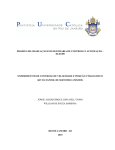Download Operating Instructions DMP 96 A
Transcript
Operating Instructions DMP 96 A Single-channel controller Two-point controller Continuous-action controller with one limit-value contact Program versions: 020H0 020H1 020H2 020H3 020H4 020H5 020H6 020H7 020H8 °C 1 2 4 3 K1 K2 Ist Soll P DMP 96 A Before connecting the regulator it is essential to read this Manual and follow it's instructions. (Subject to technical changes) DOLD GMBH . Blumenstrasse 33 . 70736 Fellbach . Germany Phone +49 (0)711/95152-0 . Fax +49 (0)711/95152-19 . [email protected] . www.dold-regler.de DOLD GMBH Operating instructions DMP 96 A Contents 1. INSTALLING THE CONTROLLER:........................................................................ 4 1.1 Directions for installation ...............................................................................................................4 1.2 Identification plate:.........................................................................................................................5 1.3 Connecting the controller: .............................................................................................................6 1.3.1 Auxiliary power: ..........................................................................................................................6 1.3.2 Terminal connection diagram:....................................................................................................6 1.4 Mechanical Data:...........................................................................................................................6 2. TECHNICAL DATA, INPUTS:................................................................................. 7 2.1 Analog inputs:................................................................................................................................7 2.1.1 Technical Data, inputs:...............................................................................................................7 2.1.2 Error-handling at input: ...............................................................................................................8 2.2 Digital inputs: .................................................................................................................................8 3. CONTROL RESPONSE: ........................................................................................ 8 3.1 Controller function: ........................................................................................................................8 3.1.1 Two-point controller:...................................................................................................................9 3.1.2 Continuous-action controller:......................................................................................................9 3.1.3 Three-point response: ................................................................................................................9 3.2 Actuator function: ..........................................................................................................................9 4. OUTPUTS: ............................................................................................................ 10 4.1 Potential-free relay contacts, make contact: ...............................................................................10 4.2 Logic output (optional): ................................................................................................................10 4.3 Analog output: .............................................................................................................................10 4.3.1 Technical data, analog output: .................................................................................................10 4.4 Output responses in cases of error: ............................................................................................11 5. DISPLAY:.............................................................................................................. 11 5.1 Upper 7-segment display ............................................................................................................11 5.2 Lower 7-segment display.............................................................................................................12 5.3 LED's: ..........................................................................................................................................12 6. EXPLANATIONS OF SYMBOLS:......................................................................... 12 DMP 96 A H0e020bA4.doc Version: 020 Edition: 07.11.2006 Number of pages: 26 2 DOLD GMBH Operating instructions DMP 96 A 7. OPERATION:........................................................................................................ 13 7.1 Setting parameters on the various levels: ...................................................................................13 7.2 The various levels: ......................................................................................................................14 7.3 Setting the setpoint:.....................................................................................................................14 7.3.1 Setting the setpoint via the operator level: ...............................................................................14 7.3.2 Setting the setpoint level via the setpoint entry level: ...............................................................15 7.4 The configuration level: ...............................................................................................................15 7.4.1 Switching response of the K 2 limit-value contact: ...................................................................19 7.5 The parameterization level: .........................................................................................................19 7.6 The self-optimization level:..........................................................................................................20 7.6.1 Monitoring the optimization process:........................................................................................22 7.7 The information level: ..................................................................................................................23 8. LINE COMPENSATION, ZERO-POINT OFFSET:................................................ 24 8.1 Line compensation: .....................................................................................................................24 8.2 Zero-point offset: .........................................................................................................................24 9. ERROR MESSAGES: ........................................................................................... 25 9.1 Error messages (display): ...........................................................................................................25 10. PROGRAM VERSION: ....................................................................................... 25 11. IMMUNITY: ......................................................................................................... 26 DMP 96 A H0e020bA4.doc Version: 020 Edition: 07.11.2006 Number of pages: 26 3 DOLD GMBH 1. Operating instructions DMP 96 A Installing the controller: 1.1 Directions for installation Important: These directions for the installation of DOLD devices have to be adhered to: If these directions are not adhered to the device may not work accurately, be destroyed or it may result in data being lost. Read all directions carefully before connecting the device. Connection to be carried out only by experts. This device is not a safety device. Safety devices have to be installed according to the relevant directions for use. Check if the power-supply voltage corresponds to rated voltage indicated on the identification plate before connecting and putting the device into operation. Fluctuations in the main voltage are only admissible within the indicated limits (specifications/identification plate). The described device is designated for the installation of switchboards. Electrical connections are to be carried out according to the connecting plan and the directions of the local electric supply company or the relevant regulations of the VDE respectively. Other consumers must not be connected to the mains terminals. In the event of mains interruptions, which lead to a malfunctioning of the device, relevant measures must be taken to avoid interruptions or interruptions must be filtered out by an external hum eliminator. The device is equipped with an internal hum eliminator. On installation the sensor lines have to be shielded. The screen must be single-ended. With regard to thermoelement pick-ups the compensating lead has to be laid as far as the control terminals. The device and inductive consumers as well as sensor lines/signal lines and high tension lines have to be placed in such a way that any mutual interference is excluded (placed separately; not parallely laid). go-and-return lines should be laid parallely and, if possible, twisted. Non-insulated sensors of a multi-channel control have to be adjusted to the same potential (max. potential difference: + 3.5 V eff.). Otherwise insulated sensors must be used (Warning: Ceramics insulations (Al-Oxide) can be conducting >400 °C). Post-connected contactors have to be equipped with RC protective allocations according to the manufacturer's instructions. If an internal protective allocation is mentioned in the connection plan of the device this has to be taken into account in the event of external allocation. If external allocation is missing short-term voltage peaks may result which lead to faster contact wear and may cause interference. The preadjustment of all parameters has to be checked during operation and adjusted to the local conditions (installation)! Wrongly adjusted parameters may cause serious malfunctions! Not all controlled systems can be controlled by parameters measured by means of selfoptimising; therefore, on principle, control response is to be checked for stability. DMP 96 A H0e020bA4.doc Version: 020 Edition: 07.11.2006 Number of pages: 26 4 DOLD GMBH Operating instructions DMP 96 A The load circuits of the relays have to be protected against excessive currents in order to avoid the relay contacts becoming welded together. The device must not be installed in an ex-area. If used for purposes other than originally intended the device may be damaged and cause damage to connected installations. The life time of the relays is limited to 106 switching cycles at a load of 500 VA. Thus it is to a high degree dependent on the frequency of switching cycles. Time per switching cycle Time after which 106 switching cycles are reached (operation: 8 hours/day at a load of 500 VA) 120 s about 11.4 years 60 s about 5.7 years 30 s about 2.8 years This table is invalid for Solid-State-Relay. At low loads life time increases with regard to the values indicated in the table. The device is to be protected against moisture (especially condensing moisture) and excessive contamination. If this is not assured the device is liable to malfunctions. Unplug connecting plugs only longitudinally to plug direction. Under no circumstances must the connecting plugs be plugged in or out obliquely! Furthermore care must be taken that the surrounding temperature corresponds to the values shown in the specifications. Sufficient air circulation must be provided. These operating instructions do not contain all directions to regulations, standards etc. which become effective when using this device in connection with other installations. These regulations, standards etc. must be ascertained and abided to by the purchaser. 1.2 Identification plate: The following information is important and should be given whenever you have any technical questions: Type of controller Factory number Program version Model number DMP 96 A ASP 675XXX Operating voltage: XXX V +/-10% Switching capacity: 500 VA at 230 V AC Factory number: Input: Logic input: Outputs: Program version: Model No: XXXXXX FXXPXXHXX XXXXX configurable function relay Logic outputs XXXXX XXXXXXXXXX Type of controller Terminal connection diagram number as per order as per order as per order Figure 1: DMP 96 A identification plate DMP 96 A H0e020bA4.doc Version: 020 Edition: 07.11.2006 Number of pages: 26 5 DOLD GMBH Operating instructions DMP 96 A 1.3 Connecting the controller: 1.3.1 Auxiliary power: Auxiliary power (operating voltage) as per identification plate: Standard: 230 V AC (±10%), 48...62 Hz, Power consumption, depending on model: ≤ 6 VA, Not affected by voltage fluctuations within the defined rangeTerminal connection diagram: 1.3.2 Terminal connection diagram: This connection diagram shows maximum terminal assignment for the controller when all connection possibilities are used. The appropriate terminal assignment (depending of the type of controller used) can be found in the accompanying connection diagram. Connection diagram number according to identification plate: ASP 675XXX Resistance thermometer, 3-wire leads + 2 3 - + - 6 7 8 9 + - Thermal converter 1 4 5 + - Resistance thermometer, 2-wire leads 10 11 12 13 14 15 Logic input U/I output Caution: Terminal 2 (-) and terminal 6 (-) do not have the same potential! Operating voltage K1 Relay outputs Logic outputs (optional) K2 Figure 2: DMP 96 A connection diagram 1.4 Mechanical Data: Protection class: Insulation group: Type of protection: DMP 96 A H0e020bA4.doc VDE 0631 C as per DIN VDE 0110 b As per DIN VDE 0470 (replaces DIN 40 050) EN 60 529 / IEC 529 Front panel: IP 50 (optionally: IP 54 with the proper mounting and a suitable sealing ring) Housing: IP 30 IP 20 Version: 020 Edition: 07.11.2006 Number of pages: 26 6 DOLD GMBH Operating instructions DMP 96 A Housing: Material: Front panel dimensions: Control panel cutout: Recess depth: Terminal connections: Weight: Ambient conditions: 2. Pull-out housing for mounting control panel per DIN 43 700 with a B fastener as per DIN 43 835 (M 4 screw clamp) PPO, glass-fiber reinforced (Noryl GFN2SE1) self-extinguishing, non-dripping fire protection class UL 94 V1 96 x 96 mm DIN 43 700 92+0.8 x 92+0.8 mm approx. 92 mm including screwed plug connector Screwed socket strips nominal cross section 2.5 mm2 approx. 500 g Operating temperature range: 0...+50°C Storage temperature range: -30...+70°C Climatic utilization category: as per DIN 40 040, corresponding to 75% relative humidity without moisture condensation. Technical data, inputs: 2.1 Analog inputs: Input as per identification plate or sensor ID: • • • Pt 100 three-wire lead Fe-CuNi thermal converter, Type L Ni Cr-Ni thermal converter, Type K. Sensor ID: Sensor: Sensor ID: ID according to ordering key: Max. display range: Max. setpoint range: Program version: Pt 100 Pt 100 Pt 100 Pt 100 Pt 100 P1 P2 P3 P4 P5 P1 P2 P3 P4 P5 -69...149°C -69...249°C -69...349°C -69...699°C -169...149°C -50...100°C -50...200°C -50...300°C -50...600°C -150...100°C 020H0 020H1 020H2 020H3 020H4 Fe-CuNi Type L Fe-CuNi Type L Ni Cr-Ni Type K Ni Cr-Ni Type K tL1 tL2 tn1 tn2 L1 L2 K1 K2 -24...499°C -24...899°C -24...649°C -24...1299°C 0...450°C 0...850°C 0...600°C 0...1200°C 020H5 020H6 020H7 020H8 (See Information Level, Section 8.7, for instructions on querying sensor ID). 2.1.1 Technical Data, inputs: Pt 100: DMP 96 A H0e020bA4.doc Sensor current: constant 1 mA DC Calibration precision: ≤ 0,15 % F.S. Linearity error: ≤ 0,1% F.S. Temperature drift characteristics: ≤ 100 ppm/K Equipped with sensor breakage cutoff and short circuit fuse Version: 020 Edition: 07.11.2006 Number of pages: 26 7 DOLD GMBH Operating instructions DMP 96 A Pt 100 three-wire lead: Pt 100 two-wire lead: Automatic line resistance compensation via software (maximum permissible line resistance: 50 Ω per lead) Line resistance correction (line compensation) of max. 9 Ω possible via software (external bridge clamps 2-3), Thermal converter: Calibration precision: ≤ 0.15% F.S. Linearity error: ≤ 0.15% F.S. Temperature drift characteristics (without reference point compensation): ≤ 80 ppm/K Effect of line resistance: ≤ 2µV/Ω Reference point compensation Error recognition using a controller reference point > 70°C Sensor breakage cutoff General: Measurement cycle: 1s Resolution: ≥ 12 bit LRC and diode protection circuit for each input Measuring-circuit monitoring: Error shown on display Protective circuits: Hardware watchdog and power-fail Data backup: EE-PROM, semiconductor storage, Hardware-protected calibrated values 2.1.2 Error-handling at input: If the input signal leaves the maximum display range (for sensor ID) this is recognized as an error, evaluated, and shown on the display (error message "Er 1"). See section 4.4, page 11. 2.2 Digital inputs: Logic input via potential-free contact, with configurable function Contact: Contact open Contact closed Enter value for setpoint 1 Enter value for setpoint 2 - Control contact K 1 deactivated Programming function block Programming function release Function: Setpoint switchover Stop function Programming block 3. Control response: 3.1 Controller function: Control response is configurable: • • Two-point response for heating or cooling, with adjustable hysteresis Two-point response for heating or cooling with PDPID – control characteristic and selfoptimization algorithm DMP 96 A H0e020bA4.doc Version: 020 Edition: 07.11.2006 Number of pages: 26 8 DOLD GMBH • • • Operating instructions DMP 96 A Continuous-action control response for heating and cooling with PDPID – control characteristic and self-optimization algorithm Three-point response with adjustable hysteresis Three-point response with one-sided PDPID – control characteristic and self-optimization algorithm 3.1.1 Two-point controller: Relay output K 1: Relay output K 2: Switching function configurable: Switching function configurable: Control contact or limit comparator Limit-value contact (with adjustable hysteresis) and limit comparator Options: Logic output in place of relay output K 1 or K 2, actual-value output. 3.1.2 Continuous-action controller: Output 1: Relay output K 2: Option: Characteristic curve configurable (heating or cooling): Control output (relay output K 1 eliminated) Switching function configurable: Limit-value contact (with adjustable hysteresis) or limit comparator Logic output in place of relay output K 2 3.1.3 Three-point response: Three-point response is configurable: Relay output K 1 heating, relay output K 2 cooling, Relay output K 1 cooling, relay output K 2 heating, Options: Logic output in place of relay output K 1 or K 2, actual-value output. 3.2 Actuator function: Reconfiguration of the "Aut" parameter makes it possible to use the unit as an actuator (actuator mode: parameter "Aut" set to OFF on the configuration level) The key can be used to switch smoothly back and forth between the controller functions (automatic function) and the actuator (manual function). The manipulated variable (%) set on the operator or setpoint entry level is relative to the cycle time (with relay output) or to output deviation (with continuous-action output). The currently activated function is stored in the EE-PROM. When the unit is powered up it is in the state of the function last stored. Display: DMP 96 A H0e020bA4.doc Version: 020 Edition: 07.11.2006 Number of pages: 26 9 DOLD GMBH Operating instructions DMP 96 A Display: Upper 7-segment display Lower 7-segment display Controller current actual value setpoint Actuator current actual value alternation between " -y- " / manipulated variable Function: 4. Outputs: Outputs as per identification plate and accompanying terminal connection diagram: 4.1 Potential-free relay contacts, make contact: Contact load: ≤ 250 V AC, ≤ 8 A resistive load at 500 VA typically 106 switching cycles 4.2 Logic output (optional): Logic outputs for activating solid-state relays, (in place of relay outputs K 1 or K 2): Open collector, not galvanically separated, short-circuit-proof, typically: 0/10 V DC, maximum: 20 mA. 4.3 Analog output: Analog output as per order and identification plate Two-point controller: Continuousaction controller: actual-value output (optional): range limits configurable Control output: Current output: output value configurable: 0...20 mA 4...20 mA Voltage output: output value as per order: 0...1 V DC 0...2 V DC 0...5 V DC characteristic curve (heating or cooling) configurable 4.3.1 Technical data, analog output: Current and voltage output: Current output: Voltage output (short-circuit-proof): Note: DMP 96 A H0e020bA4.doc resolution: load: internal resistance Ri: 8 Bit ≤ 250 Ω ≤ 250 Ω Any current output present but not needed must have a terminating resistor of ≤ 250 Ω or a bridge (terminals 5-6). Version: 020 Edition: 07.11.2006 Number of pages: 26 10 DOLD GMBH Operating instructions DMP 96 A 4.4 Output responses in cases of error: Output response in cases of sensor error: • Relay or logic outputs: • Analog output: Outputs assume the state defined on the configuration level. (continuous-action controller, actual-value output): output U: 0...1 V DC, 0...2 V DC, 0...5 V DC: output signal: output I: output I: 0...20 mA 4...20 mA output signal: output signal: 0 V DC 0 mA 0 mA Incorrect actual-value response due to sensor error or response exceeding the set range: Max. display range Beginning of range "AnL" a) 0 VDC b) 0 VDC c) 0 VDC d) 0 mA e) 0 mA a) 0 VDC b) 0 VDC c) 0 VDC d) 0 mA e) 4 mA End of range "AnH" a) 1 VDC b) 2 VDC c) 5 VDC d) 20 mA e) 20 mA a) 0...1 VDC b) 0...2 VDC c) 0...5 VDC d) 0...20 mA e) 4...20 mA a) 0 VDC b) 0 VDC c) 0 VDC d) 0 mA e) 0 mA Set analog range Error message "Er.1" (X < display range) Error message "Er.1" (X > display range) Actual value X Figure 3: Actual-value response in cases of error 5. Display: • • Actual-value and setpoint display: Setpoint display: resolution adjustable display range adjustable. General information: Powering up: When power is turned on the following displays appear: • On the upper 7-segment display: the parameter "P.nr". • On the lower 7-segment display: the current program number "X.X". After approx. 5 s the controller switches to normal operating mode. Outputs are inactive during a cold start. 5.1 Upper 7-segment display shows: • • the actual value parameter designation in entry mode DMP 96 A H0e020bA4.doc Version: 020 Edition: 07.11.2006 Number of pages: 26 11 DOLD GMBH Operating instructions DMP 96 A 5.2 Lower 7-segment display shows: • • • setpoint parameter value in entry mode alternation between " -y- " / manipulated variable when actuator function is activated (manual function) alternation between setpoint (auxiliary setpoint) / "Opt" during the self-optimization procedure. • 5.3 LED's: LED: LED: LED: LED: 6. K1 K2 1 2 yellow yellow green green lights up when output K 1 is active lights up when output K 2 is active lights up when continuous-action controller is functioning lights up when logic input is activated (contact closed) Explanations of symbols: Display: Meaning: "P.nr" "SP.1" "SP.2" " -y- " "Cod" "Con" "Cor" "rA.H" "rA.L" "Co.1" "Co.2" "Fd.1" "Fd.2" "rES" "Aut" "Co.u" "Co.A" "An.H" "An.L" "Co.L" "3-P" "uSr" "PAr" "Pb.1" "ti.1" "td.1" "CY.1" "HY.1" "bd.1" "LA.2" "Lr.2" "bd.2" "HY.2" Current program number Setpoint 1 Setpoint 2 Manipulated actuator value Code entry Enter configuration level Line compensation or zero-point offset Set upper limit of setpoint range Set lower limit of setpoint range Configuration, relay contact K 1 Configuration, relay contact K 2 fault on control output K 1 fault on control output K 2 Display resolution Configuration of automatic function Configuration of setpoint setting Configuration of analog input Setting of upper measuring range limit for actual-value output Setting of lower measuring range limit for actual-value output Configuration of logic input Configuration of three-point response Enter setpoint entry level Enter parameterization level Proportional band, control contact K 1 Reset time, control contact K 1 Derivative action time, control contact K 1 Cycle time, control contact K 1 Switching hysteresis, control contact K 1 Symmetrical. spreading, limit comparator K 1 Absolute setpoint value, limit-value contact K 2 Relative setpoint value, limit-value contact K 2 Symmetrical. spreading, limit comparator K 2 Switching hysteresis, limit-value contact K 2 DMP 96 A H0e020bA4.doc Version: 020 Edition: 07.11.2006 Number of pages: 26 12 DOLD GMBH 7. Operating instructions DMP 96 A Display: Meaning: "noP" "tun" "HLP" "OPt" "inF" "SEn" "Er.1" "Er.9" Relay contact K 2 deactivated Enter self-optimization level Correcting setpoint Self-optimization activated Enter information level Sensor ID Sensor error message System error message Operation: The operating structure of the DMP 96 A controller includes six separate levels: Setting the setpoint (depending on configuration): via the operator level. via the setpoint entry level (by entering a code). the configuration level, where line compensation, range limits, control functions, switching functions of the limit-value contact, and error allocations are defined. the parameterization level, which contains all parameters for adjusting the controller to the control loop. the self-optimization level for setting the correcting setpoint and for starting or aborting self-optimization. the information level for querying current program number and sensor ID. • • • • • • 7.1 Setting parameters on the various levels: P current value: after approx. 3 s: after approx. 6 s: +1 +10 +100 current value: after approx. 3 s: after approx. 6 s: -1 -10 -100 display value is accepted The program returns to normal operating mode after the last parameter has been confirmed. If no key is pressed within 20 seconds, the program automatically returns to normal operating mode without accepting any value that has been changed. After confirming an incorrect code number: DMP 96 A H0e020bA4.doc Version: 020 Edition: 07.11.2006 Do not press any key for approx. 20 seconds. Wait for program to return to normal operating mode. Enter new code. Number of pages: 26 13 DOLD GMBH Operating instructions DMP 96 A 7.2 The various levels: Press briefly P Operator level (only when function is released) (setpoint setting) Press for 3 s P Code 100 P Information level (querying of current program number, sensor) (only when function is released) Configuration level Code 155 P Code 55 P Code 111 P (starting and aborting of self-optimization) Code 77 P (setpoint set by entering code) (configuration of range limits, control functions, etc.) Parameter level (setting of control parameters) Self-optimization level Setpoint entry level (only when function is released) Figure 4: The various levels 7.3 Setting the setpoint: How the setpoint is set depends on configuration (parameter ”Co.u” on the configuration level). The setpoint can be set on the: • operator level (factory configuration) • setpoint entry level (setting made by entering a code number). 7.3.1 Setting the setpoint via the operator level: P Press key briefly to jump to the operator level Display: Parameter: "SP.1" DMP 96 A H0e020bA4.doc Setpoint 1 Version: 020 Edition: 07.11.2006 Range: Factory setting: "rA.L...rA.H" 0.0°C Number of pages: 26 14 DOLD GMBH Display: Operating instructions DMP 96 A Parameter: Range: Factory setting: "SP.2" Setpoint 2 (appears only for configuration "Co.L" = 01) "rA.L...rA.H" 0.0°C " y " Setpoint manipulated variable (appears only for configuration "Aut" = OFF) 0.0...100% 0.0% Display value is accepted P When configuring parameter ”Co.u” = on (setting setpoint via setpoint entry level) it is not possible to jump to the operator level. 7.3.2 Setting the setpoint level via the setpoint entry level: Press for approx. 3 s P to get display: " Cod " 100 Enter code: 77 P Confirm code: P Jump to setpoint entry level. Display: Display: Parameter: " uSr " Range: Factory setting: "SP.1" Setpoint 1 "rA.L...rA.H" 0.0°C "SP.2" Setpoint 2 (appears only for configuration "Co.L" = 01) "rA.L...rA.H" 0.0°C " y " Setpoint manipulated variable (appears only for configuration "Aut" = OFF) 0.0...100% 0.0% P Displayed value is accepted When configuring parameter ”Co.u” = OFF (setting setpoint via operator level) it is not possible to jump to the setpoint entry level. 7.4 The configuration level: P Press for approx. 3 s to get display: " Cod " 100 DMP 96 A H0e020bA4.doc Version: 020 Edition: 07.11.2006 Number of pages: 26 15 DOLD GMBH Operating instructions DMP 96 A Enter code: 155 P Confirm code: P Jump to configuration level. Display: Display: Parameter: Range: "Cor" "rA.H" Line compensation and zero-point offset Set upper limit of setpoint range (end of setpoint range) "rA.L" Set lower limit of setpoint range (beginning of setpoint range) Note: With configuration "rA.H" = "rA.L" it is not possible to set the setpoint on the operator level. With configuration "rA.H" < "rA.L" the keys or can be used to switch back and forth between the set values Configuration of control output or limit comparator K 1 "Co.1" " Con " Factory setting: -25...25.0°C 0.0°C max. setmax. setpoint range point range by sensor ID by sensor ID (Section 2.1) (Section 2.1) 0.0°C max. setpoint range by sensor ID (Section 2.1) 01...06 05 Two-point controller / three-point response: 01: 02: 03: 04: 05: 06: Cooling controller with hysteresis setting towards plus Cooling controller with PID feedback Limit comparator closed in goodband (hysteresis fix at 0.5 K) Heating controller with adjustable hysteresis towards minus Heating controller with PID feedback Limit comparator open in goodband (hysteresis fix at 0.5 K) Continuous-action controller: (parameter "Co.A" = 03 or 04, relay contact K 1 deactivated). 02: rising characteristic with PID ing" feedback 05: falling characteristic with PID ing" feedback DMP 96 A H0e020bA4.doc Version: 020 Edition: 07.11.2006 "cool"heat- Number of pages: 26 16 DOLD GMBH Display: "Co.2" Operating instructions DMP 96 A Parameter: Range: Factory setting: Configuration of limit-value contact K 2 00...06 00 00: 01: "Fd.1" "Fd.2" "rES" "Aut" "Co.u" "Co.A" Relay deactivated (no function) Absolute limit value of make contact relative to rising temperature 02: Limit value travels with setpoint, make contact relative to rising temp. 03: Limit comparator closed in goodband (hysteresis fix at 0.5 K) 04: Absolute limit value, break contact referenced to rising temperature 05: Limit value travels with setpoint, break contact relative to rising temp. 06: Limit comparator open in goodband (hysteresis fix at 0.5 K) Error allocation, outputs K 1; K 2 Output K 1 Output K 2 on: Output active in the event of error OFF: Output inactive in the event of error Display resolution 00: resolution 0.1K 01: resolution 1K Automatic function on: Automatic function mode activated (controller) OFF: Automatic function mode deactivated (actuator). key can be used to switch The from automatic function mode (controller) to manual function mode (actuator). Setting of setpoint via setpoint entry level on: Setting of setpoint via setpoint entry level activated OFF: Setting of setpoint via setpoint entry level deactivated (setpoint set via operator level). Analog output: Analog output of actual value (optional): 00: Analog output deactivated 01: Voltage/current output: 0...1 V DC, 0...2 V DC, 0...5 V DC or 0...20 mA 02: Current output: 4...20 mA on...OFF OFF OFF 00...01 00 on...OFF on on...OFF OFF 00...04 00 Continuous-action controller: (parameter "Co.A" = 03 or 04), configure the desired control function (parameter "Co.1" = 02 or 05), (relay contact K 1 is deactivated): 03: Voltage/current output: 0...1 V DC, 0...2 V DC, 0...5 V DC or 0...20 mA 04: Current output: 4...20 mA DMP 96 A H0e020bA4.doc Version: 020 Edition: 07.11.2006 Number of pages: 26 17 DOLD GMBH Display: Operating instructions DMP 96 A Parameter: Range: "An.H" Analog output of actual value High-end value of measuring range limit "An.L" Analog output of actual value Low-end value of measuring range limit "Co.L" Configuration of logic input 00: Logic input deactivated 01: Changing setpoint selection contact open: setpoint 1 contact closed: setpoint 2 02: Stop function (not in effect with continuous-action control output!) Contact closed: control contact K 1 deactivated and setpoint display goes dark (lower display) 03: Programming block Contact closed: programming function released Contact open: programming function blocked (jump to configuration, parameterization, setpoint entry and selfoptimization levels blocked). Three-point response on: Three-point response activated OFF: Three-point response deactivated "3-P" Factory setting: max. display end of setrange depoint range pendent on dependent sensor ID on sensor ID (Section 2.1) (Section 2.1) max. display 0.0°C range dependent on sensor ID (Section 2.1) 00...03 00 on...OFF OFF Configuring three-point response e.g.: heating K 1: "Co.1" = 04 or 05, cooling K 2: "Co.2" = 02 cooling K 1: heating K 2: "Co.1" = 01 or 02, "Co.2" = 05 spreading (parameter ”Lr.2”) toward plus or setting towards minus. Important: After any change of configuration or reconfiguration of outputs K 1 and K 2 (parameters "Co.1" and "Co.2") the corresponding parameters on the parameterization must be set and adapted to the directly controlled member. After any change of configuration or reconfiguration of the setpoint range (parameters "rA.H" and "rA.L") the setpoint settings on the operator level, and the setpoint entry level must be checked and adapted to the setpoint range. DMP 96 A H0e020bA4.doc Version: 020 Edition: 07.11.2006 Number of pages: 26 18 DOLD GMBH Operating instructions DMP 96 A 7.4.1 Switching response of the K 2 limit-value contact: Switching function relative to rising actual value Absolute limit value Limit value changing with setpoint value Actual value X Actual value X Setpoint value "SP.X" a) Hysteresis "HY.2" a) Hysteresis fix "HY.2" Setpoint value "LA.2" Spreading ("SP.X" + "Lr.2") b) Hysteresis "HY.2" b) Hysteresis fix "HY.2" a) Make contact (01) a) Make contact (02) b) Break contact (04) b) Break contact (05) Limit comparator closed in commodity load area Limit comparator closed in commodity load area actual value X Actual value X Symmetrical spreading "bd.2" Hysteresis 0.5 K Hysteresis 0.5 K Symmetrical Spreading "bd.2" Setpoint value "SP.X" Setpount value "SP.X" Hysteresis 0.5 K Symmetrical spreading "bd.2" Symmetrical spreading "bd.2" Hysteresis 0.5 K Coding Coding (03) (06) Figure 5: Switching response of the K 2 limit-value contact 7.5 The parameterization level: Setting control parameters: P Press for approx. 3 s to get display: " Cod " 100 Enter code: P DMP 96 A H0e020bA4.doc Confirm code: Version: 020 Edition: 07.11.2006 55 Display: " PAr " Number of pages: 26 19 DOLD GMBH Operating instructions DMP 96 A Jump to parameterization level. P Depending on the configuration of the outputs (configuration level) only those parameters are accessible which are needed for the specific function. Display: "Pb.1" "ti.1 " "td.1" "CY.1" "HY.1" "bd.1" "LA.2" "Lr.2" "bd.2" "HY.2" Parameter: Proportional band, control contact K 1 (Pb = 0.1...200% relative to setpoint range according to sensor ID, Section 2.1) Reset time, control output K 1 (adjustment zero = time 0) Derivative action time, control output K 1 (adjustment zero = time 0) Cycle time, control output K 1 Range: Factory setting: 0.1...200% "Co.1" = 02, 05 5.0% 0...999 s "Co.1" = 02, 05 0...500 s "Co.1" = 02, 05 1...200 s "Co.1" = 02, 05 Hysteresis, control output K 1 0.1...5% of setpoint range limit dependent on sensor ID "Co.1" = 01, 04 Symmetrical spreading, limit comparator 0.1...99.9 K K 1 (hysteresis fix at 0.5 K) "Co.1" = 03, 06 Absolute setpoint, limit-value contact K 2 max. display range dependent on sensor ID "Co.2" = 01, 04 Spreading, limit-value contact K 2 travel-99...99.9 K ing with setpoint "Co.2" = 02, 05 Symmetrical spreading, limit comparator 0.1...99.9 K K 2 (hysteresis fix at 0.5 K) "Co.2" = 03, 06 Hysteresis, limit contact K 2 0.1...20% of setpoint range limit dependent on sensor ID "Co.2" = 01, 02, 04, 05 250 s 50 s 30 s 1.0 K 5.0 K 0.0 °C 0.0 K 5.0 K 1.0 K 7.6 The self-optimization level: The DMP 96 A controller is equipped with an optimization routine for the automatic adaptation of the controller to the controlled system. The optimization algorithm is based on modified Ziegler-Nicols rules, according to which the characteristic data of the system are calculated after an oscillation test in a closed-loop control circuit. These characteristic data (particularly period and amplitude of oscillation) form the basis for calculating specific parameters. Depending on the control function (heating controller or cooling controller), parameters are calculated for either the heating or the cooling side. DMP 96 A H0e020bA4.doc Version: 020 Edition: 07.11.2006 Number of pages: 26 20 DOLD GMBH Operating instructions DMP 96 A Starting and aborting optimization: Optimization can be started or aborted on the self-optimization level (only when function is released). Optimization optimizes for heating or cooling (heating controller or cooling controller, depending on configuration). Press for approx. 3 s P to get display: " Cod " 100 Enter code: 111 P Confirm code: P Jump to self-optimization level. Display: "HLP" Display: Parameter: Correcting setpoint (see formula) 70...100 % for heating 100...130 % for cooling "Opt" "on" " tun " Range: Factory setting: 70...130 % 90 % Start self-optimization P "Opt" "OFF" "OFF" Confirm Abort self-optimization P Confirm For optimization the algorithm uses a correcting setpoint which is spread by the value set for the setpoint (parameter "HLP"). This correcting setpoint prevents temperature peaks occurring above the setpoint during optimization from damaging the controlled commodity. The optimization difference must be adjusted to the specific application. Setpoint ( °C) ⋅ Parameter " HLP" (%) Corr. setpoint ( °C) = 100 (%) During the optimization process the controller works with a P-regulating characteristic curve (Pb = 0,1%). Setpoint (correcting setpoint) / "OPt" are appear alternately on the display as a visual check. To calculate parameters the controller requires two oscillations, after which it brings the control variable in line with the setpoint. DMP 96 A H0e020bA4.doc Version: 020 Edition: 07.11.2006 Number of pages: 26 21 Operating instructions DMP 96 A DOLD GMBH After completion of the optimization process only the current setpoint appears in the lower display. The calculated parameters are stored in the power-outage-proof EE-PROM, from where they can be retrieved at any time and modified manually. Self-optimization is aborted during any interruption of power supply. Example of heating optimization Contolled variable Controlled variable Optimization to setpoint value Optimization at after control startup Setpoint value Setpoint value Optimization difference Correcting setpoint value Correcting setpoint value t t Start optimization Start optimization Example of cooling optimization Controlled variable Controlled variable Optimization at Optimization to setpoint value startup after control Correcting setpoint value Hilfssollwert Correcting setpoint value Optimization difference Setpoint value Sollwert Setpoint value t Start optimization t Start optimization Figure 6: Self-optimization examples 7.6.1 Monitoring the optimization process: The diagrams show possible incorrect settings with suggestions as to how to correct them. DMP 96 A H0e020bA4.doc Version: 020 Edition: 07.11.2006 Number of pages: 26 22 Operating instructions DMP 96 A DOLD GMBH X X X (°C) (°C) (°C) W W W Optimum setting Pb too small Control oscillating Pb too large slow start-up and poor control t t t X X X (°C) (°C) (°C) W W W Optimum setting Ti too small Ti too large t t t X X (°C) X (°C) (°C) W W W Td too large Optimum setting Td too small t t t Figure 7: Incorrect settings of the feedback parameters 7.7 The information level: P Press for approx. 3 s to get display: " Cod " 100 P Display: P Jump to information level Display: Parameter: "Pnr" Current program number DMP 96 A H0e020bA4.doc Version: 020 Edition: 07.11.2006 " inF " Number of pages: 26 23 Operating instructions DMP 96 A DOLD GMBH Display: Parameter: "SEn" Sensor ID as in table Sensor ID: 8. Sensor ID: ID by ordering key: Sensor: Max. display range: Max. setpoint range: Display: P1 P2 P3 P4 P5 P1 P2 P3 P4 P5 Pt 100 Pt 100 Pt 100 Pt 100 Pt 100 -69...149°C -69...249°C -69...349°C -69...699°C -169...149°C -50...100°C -50...200°C -50...300°C -50...600°C -150...100°C 3 digits 3 digits 3 digits 3 digits 4 digits tL1 tL2 tn1 tn2 L1 L2 K1 K2 Fe-CuNi Type L Fe-CuNi Type L Ni Cr-Ni Type K Ni Cr-Ni Type K -24...499°C -24...899°C -24...649°C -24...1299°C 0...450°C 0...850°C 0...600°C 0...1200°C 3 digi ts 3 digi ts 3 dig its 4 d igits Line compensation, zero-point offset: 8.1 Line compensation: Line compensation is required only with resistance thermometers in two-wire technology. Line resistance can be counterbalanced with the "Cor" parameter (configuration level). Proceed as follows to generate line compensation: 1. 2. 3. 4. Connect a 100 Ω resistor to the end of the sensor line (corresponds to 0°C). Read off the actual value from the display. Jump to the configuration level. Correct line resistance (display in °C) with the "Cor" parameter. Example: 1. 2. 3. 4. 5. Displayed actual value: "Cor" value to be set on the configuration level: Confirm the set value with the P key. Return to operating mode Display of actual value: Remove 100 Ω resistor from end of line. +3.0°C -3.0°C 0.0°C 8.2 Zero-point offset: The "Cor" parameter can also be used for zero-point offset (offset value) towards plus or minus (as in the above example). DMP 96 A H0e020bA4.doc Version: 020 Edition: 07.11.2006 Number of pages: 26 24 Operating instructions DMP 96 A DOLD GMBH 9. Error messages: 9.1 Error messages (display): Error display: Cause: Er. 1 Pt 100 input: Er. 1 Thermal converter input: Remedy / Explanation: Sensor short circuit or Lower range limit exceeded, Sensor breakage or Upper range limit exceeded. Sensor breakage or Upper range limit exceeded, Sensor poles reversed or Upper range limit, exceeded Ambient temperature of controller > 70°C. Er. 9 System error Check sensor Check sensor Check ambient temperature of controller Switch unit off/on 10. Program version: Current program version: 0 20 H0 factory number current program number unit-specific number • Version 020: DMP 96 A H0e020bA4.doc Status: 19.02.96 Version: 020 Edition: 07.11.2006 Basic version: Single-channel controller (twopoint controller, continuousaction controller) with analog output and logic input. Number of pages: 26 25 Operating instructions DMP 96 A DOLD GMBH 11. Immunity: The immunity of the unit was tested with the following interference simulators manufactured by the Schaffner Company (Switzerland). • NSG 222A: Interference pulses with broadband spectrum, short build-up time and low energy Test values: • NSG 225A: NSG 203A: H0e020bA4.doc Stage 3: Repetition frequency: 2000 V 5 kHz Testing after power outages Test values: DMP 96 A ± 2500 V 5 ns Interference pulse package with broad interference spectrum Test values: • pulse amplitude Rise time: Symmetrical and asymmetric feed at 100% supply voltage dip: Repetition frequency: Version: 020 Edition: 07.11.2006 Number of pages: 26 50 ms 1 Hz. 26



























